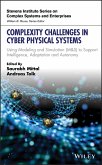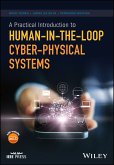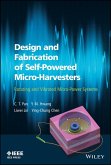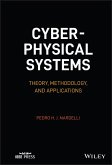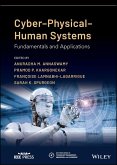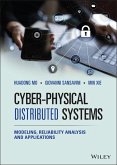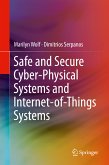Self-Powered Cyber Physical Systems (eBook, PDF)
Redaktion: Gatti, Rathishchandra R.; Singh, Chandra; Serrao, Felcy Jyothi; Agrawal, Rajeev


Alle Infos zum eBook verschenken

Self-Powered Cyber Physical Systems (eBook, PDF)
Redaktion: Gatti, Rathishchandra R.; Singh, Chandra; Serrao, Felcy Jyothi; Agrawal, Rajeev
- Format: PDF
- Merkliste
- Auf die Merkliste
- Bewerten Bewerten
- Teilen
- Produkt teilen
- Produkterinnerung
- Produkterinnerung

Hier können Sie sich einloggen

Bitte loggen Sie sich zunächst in Ihr Kundenkonto ein oder registrieren Sie sich bei bücher.de, um das eBook-Abo tolino select nutzen zu können.
This book is an attempt to aim at a very futuristic vision of achieving self-powered cyber-physical systems by applying a multitude of current technologies such as ULP electronics, thin film electronics, ULP transducers, autonomous wireless sensor networks using energy harvesters at the component level and energy efficient clean energy for powering data centers and machines at the system level. This is the need of the hour for cyber-physical systems since data requires energy when it is stored, transmitted, or converted to other forms. Cyber-physical systems will become energy hungry since the…mehr
- Geräte: PC
- mit Kopierschutz
- eBook Hilfe
- Größe: 8.94MB
![Complexity Challenges in Cyber Physical Systems (eBook, PDF) Complexity Challenges in Cyber Physical Systems (eBook, PDF)]() Complexity Challenges in Cyber Physical Systems (eBook, PDF)114,99 €
Complexity Challenges in Cyber Physical Systems (eBook, PDF)114,99 €![A Practical Introduction to Human-in-the-Loop Cyber-Physical Systems (eBook, PDF) A Practical Introduction to Human-in-the-Loop Cyber-Physical Systems (eBook, PDF)]() David NunesA Practical Introduction to Human-in-the-Loop Cyber-Physical Systems (eBook, PDF)97,99 €
David NunesA Practical Introduction to Human-in-the-Loop Cyber-Physical Systems (eBook, PDF)97,99 €![Design and Fabrication of Self-Powered Micro-Harvesters (eBook, PDF) Design and Fabrication of Self-Powered Micro-Harvesters (eBook, PDF)]() C. T. PanDesign and Fabrication of Self-Powered Micro-Harvesters (eBook, PDF)123,99 €
C. T. PanDesign and Fabrication of Self-Powered Micro-Harvesters (eBook, PDF)123,99 €![Cyber-physical Systems (eBook, PDF) Cyber-physical Systems (eBook, PDF)]() Pedro H. J. NardelliCyber-physical Systems (eBook, PDF)96,99 €
Pedro H. J. NardelliCyber-physical Systems (eBook, PDF)96,99 €![Cyber-Physical-Human Systems (eBook, PDF) Cyber-Physical-Human Systems (eBook, PDF)]() Cyber-Physical-Human Systems (eBook, PDF)107,99 €
Cyber-Physical-Human Systems (eBook, PDF)107,99 €![Cyber-Physical Distributed Systems (eBook, PDF) Cyber-Physical Distributed Systems (eBook, PDF)]() Huadong MoCyber-Physical Distributed Systems (eBook, PDF)113,99 €
Huadong MoCyber-Physical Distributed Systems (eBook, PDF)113,99 €![Safe and Secure Cyber-Physical Systems and Internet-of-Things Systems (eBook, PDF) Safe and Secure Cyber-Physical Systems and Internet-of-Things Systems (eBook, PDF)]() Marilyn WolfSafe and Secure Cyber-Physical Systems and Internet-of-Things Systems (eBook, PDF)46,95 €
Marilyn WolfSafe and Secure Cyber-Physical Systems and Internet-of-Things Systems (eBook, PDF)46,95 €-
-
-
Dieser Download kann aus rechtlichen Gründen nur mit Rechnungsadresse in A, B, BG, CY, CZ, D, DK, EW, E, FIN, F, GR, HR, H, IRL, I, LT, L, LR, M, NL, PL, P, R, S, SLO, SK ausgeliefert werden.
- Produktdetails
- Verlag: Wiley-IEEE Press
- Seitenzahl: 416
- Erscheinungstermin: 6. September 2023
- Englisch
- ISBN-13: 9781119842019
- Artikelnr.: 68885129
- Verlag: Wiley-IEEE Press
- Seitenzahl: 416
- Erscheinungstermin: 6. September 2023
- Englisch
- ISBN-13: 9781119842019
- Artikelnr.: 68885129
- Herstellerkennzeichnung Die Herstellerinformationen sind derzeit nicht verfügbar.
Acknowledgements xxiii
1 Self-Powered Sensory Transducers: A Way Toward Green Internet of Things 1
Rajeev Ranjan
1.1 Introduction 1
1.2 Need of the Work 3
1.3 Energy Scavenging Schemes in WSAN 4
1.4 Self Powered Systems and Green IoT (G-IoT) 10
1.5 Application Area and Scope of Self-Powered System in G-IoT 11
1.6 Challenges and Future Scope of the Self-Powered G-IoT 22
1.7 Conclusion 27
2 Self-Powered Wireless Sensor Networks in Cyber Physical System 41
Srividya P.
2.1 Introduction 42
2.2 Wireless Sensor Networks in CPS 43
2.3 Architecture of WSNs with Energy Harvesting 44
2.4 Energy Harvesting for WSN 44
2.5 Energy Harvesting Due to Mechanical Vibrations 45
2.6 Piezoelectric Generators 46
2.7 Piezoelectric Materials 47
2.8 Types of Piezoelectric Structures 48
2.9 Hybridized Nanogenerators for Energy Harvesting 55
2.10 Conclusion 56
3 The Emergence of Cyber-Physical System in the Context of Self-Powered
Soft Robotics 57
Darwin S. and Fantin Irudaya Raj E.
3.1 Introduction 58
3.2 Actuators and Its Types 59
3.3 Soft Actuator Electrodes 69
3.4 Sensors 72
3.5 Soft Robotic Structures and Control Methods 74
3.6 Soft Robot Applications 76
3.7 Future Scope 79
3.8 Conclusion 82
4 Dynamic Butterfly Optimization Algorithm-Based Task Scheduling for
Minimizing Energy Consumption in Distributed Green Data Centers 91
Sengathir Janakiraman and Deva Priya M.
4.1 Introduction 92
4.2 Related Work 94
4.3 Improved Dynamic Butterfly Optimization Algorithm (IDBOA)-Based Task
Scheduling (IDBOATS) 99
4.4 Results and Discussion 106
4.5 Conclusion 110
5 Wireless Power Transfer for IoT Applications--A Review 115
Sasikala G. and Rajeev Ranjan
5.1 Introduction 116
5.2 Sensors 116
5.3 Actuators 118
5.4 Energy Requirement in Wireless Sensor Networks (WSNs) 119
5.5 Wireless Sensor Network and Green IoT (G-IoT) 121
5.6 Purpose of G-IoT 122
5.7 Motivation 124
5.8 Contribution 124
5.9 Need of the Work 125
5.10 Energy Transferring Schemes in WSAN 126
5.11 Electromagnetic Induction 127
5.12 Inductive Coupling 131
5.13 Resonance Inductive Coupling 132
5.14 Wireless Power Transmission Using Microwaves 133
5.15 Electromagnetic Radiations 135
5.16 Conclusion 135
6 Adaptive Energy Intelligence Using AI/ML Techniques 141
Gowthamani R., Sasi Kala Rani K., Manikandan M. and Rohini M.
6.1 Introduction 142
6.2 Evolution of Cyber Physical System 144
6.3 Relationship With Internet of Things 146
6.4 Challenges in Design and Integration of Cyber Physical Systems 147
6.5 Future Challenges and Promises 149
6.6 Machine Learning Models 149
6.7 Estimation of Building Energy Consumption 150
6.8 Development of Artificial Intelligence 150
6.9 Usage of AI/ML in Adaptive Energy Management 151
6.10 Use of Hybrid/Ensemble Machine Learning Algorithm for Better
Prediction 152
6.11 Conclusion 155
7 Renewable Energy Smart Grids for Electric Vehicles 159
Vishal H. Kanchan, Preethesh B., Hithesh Alen D'Costa, Sohan R. Alva and
Rathishchandra Ramachandra Gatti
7.1 Introduction 160
7.2 Integration of Electric Vehicles (EVs) into the Power Grid 161
7.3 EV Charging and Electric Grid Interaction 161
7.4 EVs with V2G System Architecture 163
7.5 EVs and Smart Grid Infrastructure 164
7.6 Renewable Energy Sources Integration With EVs 165
7.7 Application in Transport Sector 167
7.8 Application in Micro-Grid 169
7.9 State-of-the-Art Review 170
7.10 Future Trends 172
8 Recent Advances in Integrating Renewable Energy Micro-Grid Systems With
Electric Vehicles 177
Hithesh Alen D'Costa, Sohan R. Alva, Vishal H. Kanchan, Preethesh B. and
Rathishchandra R. Gatti
8.1 Introduction 178
8.2 Electric Vehicles and Renewable Energy Sources: A General Overview 179
8.3 Microgrid 183
8.4 Interactions Between Cost-Conscious EVs and RESs 186
8.5 Interaction Between Efficiency-Conscious EVs and RESs 188
8.6 Open Problems 190
8.7 Conclusion 191
9 Overview of Fast Charging Technologies of Electric Vehicles 193
Sohan R. Alva, Vishal H. Kanchan, Preethesh B., Hithesh Alen D'Costa and
Rathishchandra Ramachandra Gatti
9.1 Introduction 194
9.2 Different Levels of Charging Electric Vehicles 194
9.3 State-of-the-Art Fast-Charging Implementation 197
9.4 DC Fast-Charging Structure 199
9.5 Fast Chargers 200
9.6 Today's Situation and Future Needs 201
9.7 Fast-Charging Point Power Requirements 202
9.8 Recent Technologies in Fast Charging, Machine Learning, and Artificial
Intelligence 203
9.9 Effect of Fast Charging on EV Powertrain Systems 205
9.10 Grid Impacts Caused by EV Charging 207
9.11 Fast-Charging Technologies on the Self-Powered Automotive
Cyber-Physical Systems 208
9.12 Conclusions 209
10 A Survey of VANET Routing Attacks and Defense Mechanisms in Intelligent
Transportation System 213
Allam Balaram, P. Chandana, Shaik Abdul Nabi and M. SilpaRaj
10.1 Introduction 214
10.2 Attacks in VANET 215
10.3 Impacts of Attacks on VANET Routing 216
10.4 Nonintentional Misbehavior 217
10.5 Intentional Misbehavior 217
10.6 Defence Mechanism of Routing Attacks in VANET Routing 218
10.7 Intrusion Detection Techniques in VANETs 220
10.8 Anonymous Routing in VANETs 221
10.9 Challenges and Future Directions 222
10.10 Conclusion 223
11 ANN-Based Cracking Model for Flexible Pavement in the Urban Roads 227
Athiappan K., Kandasamy A., Karthik C. and Rajalakshmi M.
11.1 Introduction 228
11.2 Literature Review 229
11.3 Methodology 230
11.4 Structural Number 234
11.5 Modeling Methodology 235
11.6 Model Validation 238
11.7 Sensitivity Analysis 238
11.8 Conclusions 241
11.9 Limitations 241
11.10 Future Scope of Study 241
12 A Review of Autonomous Vehicles 243
Joyston J. D'Costa and Ajith B.S.
12.1 Introduction 244
12.2 History 245
12.3 Degrees in Automation 246
12.4 Benefits and Drawbacks 247
12.5 Working Principle of Autonomous Vehicles 249
12.6 Mechanics Involved 250
12.7 Conclusion 252
13 Meeting Privacy Concerns in Intelligent Transportation Systems 255
Sharon D. John
13.1 Introduction 255
13.2 Synopsis of ITS 257
13.3 Future Research Direction 260
13.4 Contributions to this Research 261
13.5 Conclusions 262
14 Feasibility Study of Digital Twin in Automotive Industry--Trends and
Challenges 265
Preethesh B., Hithesh Alen D'Costa, Sohan R. Alva, Vishal H. Kanchan and
Rathishchandra R. Gatti
14.1 Introduction 266
14.2 Industrial Evolution 267
14.3 Influence of IoT on Digital Twin 268
14.4 Digital Twin in CPS Applications 269
14.5 Digital Twin Types 270
14.6 Levels of Digital Twin 271
14.7 Digital Thread 272
14.8 State-of-the-Art Digital Twin Deployment 273
14.9 Benefits of Digital Twin 274
14.10 Digital Twin Life Cycle 275
14.11 Digital Twin in Automotive Industry 276
14.12 Applications of Digital Twinning Technology in the Automotive
Industry 277
14.13 Role of Digital Twins in Addressing Current Automotive Challenges 279
14.14 Challenges for Implementing Digital Twin in Automotive Industry 280
14.15 Bridging the Gap 280
15 State-of-the-Art and Future Applications of Farming Robotics 283
Badrinath A.R., Abhishek Kamath, Veerishetty Arun Kumar, Nishan Rai and
Rathishchandra R. Gatti
15.1 Introduction 283
15.2 Components of Agricultural Robots 285
15.3 Types of Agricultural Robots 288
15.4 Implementation of Robotics in the Agricultural Process 290
15.5 Challenges 294
15.6 Conclusions 295
16 Review on Robot Operating System 297
G. Vijeth and Rathishchandra R. Gatti
16.1 Introduction 297
16.2 Nomenclature 301
16.3 ROS Implementation 303
16.4 Conclusion 306
17 An Overview of Collaborative Robots and Their Applications 309
Rao S. Krishna and Lawrence J. Fernandes
17.1 Introduction 309
17.2 Art of Study 310
17.3 Implementation of Collaborative Robots 314
17.4 Conclusion 318
18 State-of-the-Art and Future Applications of Powered Exoskeleton 321
C.P. Dheeshith, K. Abhijith, A. Shahaas, Rithin B. Nambiar and
Rathishchandra R. Gatti
18.1 Introduction 321
18.2 Powered Exoskeleton 323
18.3 State of the Art 324
18.4 Design Parameters to be Considered 325
18.5 Challenges to Tackle 328
18.6 Applications of Powered Exoskeleton 328
18.7 Conclusion 330
19 An Overview of Recent Trends in Consumer Robotics 333
Pramod Rao M., Shrihari P.C., Manoj, Shankar Gouda S. and Rathishchandra R.
Gatti
19.1 Introduction 333
19.2 Entertainment Robot 334
19.3 Educational Robot 335
19.4 Social Robot 336
19.5 Toy Robot 337
19.6 Conclusion 338
20 Soft Robotics in Waste Management 341
S. Rithvik, Vijith Rai, Surya Dornal, Deepak J. and B.C. Pramod
20.1 Introduction 341
20.2 Soft Robotics Insights 342
20.3 Soft Robots in Waste Management 343
20.4 Are Soft Robots the First Step for a Sustainable Future? 346
20.5 Conclusions 347
21 State-of-the-Art Review of Robotics in Crop Agriculture 349
A. Shahaas, Rithin, B. Nambiar, C.P. Dheeshith, K. Abhijith and
Rathishchandra R. Gatti
21.1 Introduction 349
21.2 Scope 350
21.3 Advantages 351
21.4 Disadvantages 352
21.5 Applications 352
21.6 Automation in Agriculture 354
21.7 Precision Agriculture 356
21.8 Conclusion 357
References 357
Index 359
Acknowledgements xxiii
1 Self-Powered Sensory Transducers: A Way Toward Green Internet of Things 1
Rajeev Ranjan
1.1 Introduction 1
1.2 Need of the Work 3
1.3 Energy Scavenging Schemes in WSAN 4
1.4 Self Powered Systems and Green IoT (G-IoT) 10
1.5 Application Area and Scope of Self-Powered System in G-IoT 11
1.6 Challenges and Future Scope of the Self-Powered G-IoT 22
1.7 Conclusion 27
2 Self-Powered Wireless Sensor Networks in Cyber Physical System 41
Srividya P.
2.1 Introduction 42
2.2 Wireless Sensor Networks in CPS 43
2.3 Architecture of WSNs with Energy Harvesting 44
2.4 Energy Harvesting for WSN 44
2.5 Energy Harvesting Due to Mechanical Vibrations 45
2.6 Piezoelectric Generators 46
2.7 Piezoelectric Materials 47
2.8 Types of Piezoelectric Structures 48
2.9 Hybridized Nanogenerators for Energy Harvesting 55
2.10 Conclusion 56
3 The Emergence of Cyber-Physical System in the Context of Self-Powered
Soft Robotics 57
Darwin S. and Fantin Irudaya Raj E.
3.1 Introduction 58
3.2 Actuators and Its Types 59
3.3 Soft Actuator Electrodes 69
3.4 Sensors 72
3.5 Soft Robotic Structures and Control Methods 74
3.6 Soft Robot Applications 76
3.7 Future Scope 79
3.8 Conclusion 82
4 Dynamic Butterfly Optimization Algorithm-Based Task Scheduling for
Minimizing Energy Consumption in Distributed Green Data Centers 91
Sengathir Janakiraman and Deva Priya M.
4.1 Introduction 92
4.2 Related Work 94
4.3 Improved Dynamic Butterfly Optimization Algorithm (IDBOA)-Based Task
Scheduling (IDBOATS) 99
4.4 Results and Discussion 106
4.5 Conclusion 110
5 Wireless Power Transfer for IoT Applications--A Review 115
Sasikala G. and Rajeev Ranjan
5.1 Introduction 116
5.2 Sensors 116
5.3 Actuators 118
5.4 Energy Requirement in Wireless Sensor Networks (WSNs) 119
5.5 Wireless Sensor Network and Green IoT (G-IoT) 121
5.6 Purpose of G-IoT 122
5.7 Motivation 124
5.8 Contribution 124
5.9 Need of the Work 125
5.10 Energy Transferring Schemes in WSAN 126
5.11 Electromagnetic Induction 127
5.12 Inductive Coupling 131
5.13 Resonance Inductive Coupling 132
5.14 Wireless Power Transmission Using Microwaves 133
5.15 Electromagnetic Radiations 135
5.16 Conclusion 135
6 Adaptive Energy Intelligence Using AI/ML Techniques 141
Gowthamani R., Sasi Kala Rani K., Manikandan M. and Rohini M.
6.1 Introduction 142
6.2 Evolution of Cyber Physical System 144
6.3 Relationship With Internet of Things 146
6.4 Challenges in Design and Integration of Cyber Physical Systems 147
6.5 Future Challenges and Promises 149
6.6 Machine Learning Models 149
6.7 Estimation of Building Energy Consumption 150
6.8 Development of Artificial Intelligence 150
6.9 Usage of AI/ML in Adaptive Energy Management 151
6.10 Use of Hybrid/Ensemble Machine Learning Algorithm for Better
Prediction 152
6.11 Conclusion 155
7 Renewable Energy Smart Grids for Electric Vehicles 159
Vishal H. Kanchan, Preethesh B., Hithesh Alen D'Costa, Sohan R. Alva and
Rathishchandra Ramachandra Gatti
7.1 Introduction 160
7.2 Integration of Electric Vehicles (EVs) into the Power Grid 161
7.3 EV Charging and Electric Grid Interaction 161
7.4 EVs with V2G System Architecture 163
7.5 EVs and Smart Grid Infrastructure 164
7.6 Renewable Energy Sources Integration With EVs 165
7.7 Application in Transport Sector 167
7.8 Application in Micro-Grid 169
7.9 State-of-the-Art Review 170
7.10 Future Trends 172
8 Recent Advances in Integrating Renewable Energy Micro-Grid Systems With
Electric Vehicles 177
Hithesh Alen D'Costa, Sohan R. Alva, Vishal H. Kanchan, Preethesh B. and
Rathishchandra R. Gatti
8.1 Introduction 178
8.2 Electric Vehicles and Renewable Energy Sources: A General Overview 179
8.3 Microgrid 183
8.4 Interactions Between Cost-Conscious EVs and RESs 186
8.5 Interaction Between Efficiency-Conscious EVs and RESs 188
8.6 Open Problems 190
8.7 Conclusion 191
9 Overview of Fast Charging Technologies of Electric Vehicles 193
Sohan R. Alva, Vishal H. Kanchan, Preethesh B., Hithesh Alen D'Costa and
Rathishchandra Ramachandra Gatti
9.1 Introduction 194
9.2 Different Levels of Charging Electric Vehicles 194
9.3 State-of-the-Art Fast-Charging Implementation 197
9.4 DC Fast-Charging Structure 199
9.5 Fast Chargers 200
9.6 Today's Situation and Future Needs 201
9.7 Fast-Charging Point Power Requirements 202
9.8 Recent Technologies in Fast Charging, Machine Learning, and Artificial
Intelligence 203
9.9 Effect of Fast Charging on EV Powertrain Systems 205
9.10 Grid Impacts Caused by EV Charging 207
9.11 Fast-Charging Technologies on the Self-Powered Automotive
Cyber-Physical Systems 208
9.12 Conclusions 209
10 A Survey of VANET Routing Attacks and Defense Mechanisms in Intelligent
Transportation System 213
Allam Balaram, P. Chandana, Shaik Abdul Nabi and M. SilpaRaj
10.1 Introduction 214
10.2 Attacks in VANET 215
10.3 Impacts of Attacks on VANET Routing 216
10.4 Nonintentional Misbehavior 217
10.5 Intentional Misbehavior 217
10.6 Defence Mechanism of Routing Attacks in VANET Routing 218
10.7 Intrusion Detection Techniques in VANETs 220
10.8 Anonymous Routing in VANETs 221
10.9 Challenges and Future Directions 222
10.10 Conclusion 223
11 ANN-Based Cracking Model for Flexible Pavement in the Urban Roads 227
Athiappan K., Kandasamy A., Karthik C. and Rajalakshmi M.
11.1 Introduction 228
11.2 Literature Review 229
11.3 Methodology 230
11.4 Structural Number 234
11.5 Modeling Methodology 235
11.6 Model Validation 238
11.7 Sensitivity Analysis 238
11.8 Conclusions 241
11.9 Limitations 241
11.10 Future Scope of Study 241
12 A Review of Autonomous Vehicles 243
Joyston J. D'Costa and Ajith B.S.
12.1 Introduction 244
12.2 History 245
12.3 Degrees in Automation 246
12.4 Benefits and Drawbacks 247
12.5 Working Principle of Autonomous Vehicles 249
12.6 Mechanics Involved 250
12.7 Conclusion 252
13 Meeting Privacy Concerns in Intelligent Transportation Systems 255
Sharon D. John
13.1 Introduction 255
13.2 Synopsis of ITS 257
13.3 Future Research Direction 260
13.4 Contributions to this Research 261
13.5 Conclusions 262
14 Feasibility Study of Digital Twin in Automotive Industry--Trends and
Challenges 265
Preethesh B., Hithesh Alen D'Costa, Sohan R. Alva, Vishal H. Kanchan and
Rathishchandra R. Gatti
14.1 Introduction 266
14.2 Industrial Evolution 267
14.3 Influence of IoT on Digital Twin 268
14.4 Digital Twin in CPS Applications 269
14.5 Digital Twin Types 270
14.6 Levels of Digital Twin 271
14.7 Digital Thread 272
14.8 State-of-the-Art Digital Twin Deployment 273
14.9 Benefits of Digital Twin 274
14.10 Digital Twin Life Cycle 275
14.11 Digital Twin in Automotive Industry 276
14.12 Applications of Digital Twinning Technology in the Automotive
Industry 277
14.13 Role of Digital Twins in Addressing Current Automotive Challenges 279
14.14 Challenges for Implementing Digital Twin in Automotive Industry 280
14.15 Bridging the Gap 280
15 State-of-the-Art and Future Applications of Farming Robotics 283
Badrinath A.R., Abhishek Kamath, Veerishetty Arun Kumar, Nishan Rai and
Rathishchandra R. Gatti
15.1 Introduction 283
15.2 Components of Agricultural Robots 285
15.3 Types of Agricultural Robots 288
15.4 Implementation of Robotics in the Agricultural Process 290
15.5 Challenges 294
15.6 Conclusions 295
16 Review on Robot Operating System 297
G. Vijeth and Rathishchandra R. Gatti
16.1 Introduction 297
16.2 Nomenclature 301
16.3 ROS Implementation 303
16.4 Conclusion 306
17 An Overview of Collaborative Robots and Their Applications 309
Rao S. Krishna and Lawrence J. Fernandes
17.1 Introduction 309
17.2 Art of Study 310
17.3 Implementation of Collaborative Robots 314
17.4 Conclusion 318
18 State-of-the-Art and Future Applications of Powered Exoskeleton 321
C.P. Dheeshith, K. Abhijith, A. Shahaas, Rithin B. Nambiar and
Rathishchandra R. Gatti
18.1 Introduction 321
18.2 Powered Exoskeleton 323
18.3 State of the Art 324
18.4 Design Parameters to be Considered 325
18.5 Challenges to Tackle 328
18.6 Applications of Powered Exoskeleton 328
18.7 Conclusion 330
19 An Overview of Recent Trends in Consumer Robotics 333
Pramod Rao M., Shrihari P.C., Manoj, Shankar Gouda S. and Rathishchandra R.
Gatti
19.1 Introduction 333
19.2 Entertainment Robot 334
19.3 Educational Robot 335
19.4 Social Robot 336
19.5 Toy Robot 337
19.6 Conclusion 338
20 Soft Robotics in Waste Management 341
S. Rithvik, Vijith Rai, Surya Dornal, Deepak J. and B.C. Pramod
20.1 Introduction 341
20.2 Soft Robotics Insights 342
20.3 Soft Robots in Waste Management 343
20.4 Are Soft Robots the First Step for a Sustainable Future? 346
20.5 Conclusions 347
21 State-of-the-Art Review of Robotics in Crop Agriculture 349
A. Shahaas, Rithin, B. Nambiar, C.P. Dheeshith, K. Abhijith and
Rathishchandra R. Gatti
21.1 Introduction 349
21.2 Scope 350
21.3 Advantages 351
21.4 Disadvantages 352
21.5 Applications 352
21.6 Automation in Agriculture 354
21.7 Precision Agriculture 356
21.8 Conclusion 357
References 357
Index 359

